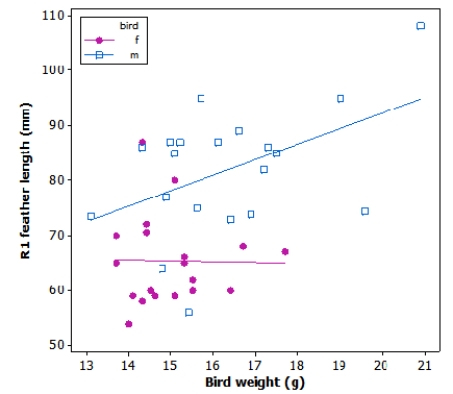Multiple Choice
Tail-feather length in birds is sometimes a sexually dimorphic trait. That is, the trait differs substantially for males and for females. Researchers studied the relationship between tail-feather length (measuring the R1 central tail feather) and weight in a sample of 20 male and 21 female long-tailed finches raised in an aviary. What is a meaningful interpretation in context of the estimate of the y intercept of the least squares line for males (blue squares) ?
What is a meaningful interpretation in context of the estimate of the y intercept of the least squares line for males (blue squares) ?
A) There is no meaningful interpretation, since a bird with 0 weight is not possible.
B) For each additional gram of weight, we estimate the tail feather length to increase by 3 mm, on average.
C) For each additional gram of weight, we estimate the tail feather length to increase by 70 mm, on average.
D) We estimate the tail feather length to be 70 mm, on average.
Correct Answer:

Verified
Correct Answer:
Verified
Q2: Tail-feather length in birds is sometimes
Q3: Tail-feather length in birds is sometimes a
Q4: Which of the following statements is correct?<br>A)The
Q5: Tail-feather length in birds is sometimes
Q6: Before surgical removal of a diseased parathyroid
Q8: One of nature's patterns connects the
Q9: Babies typically learn to crawl approximately
Q10: A researcher noticed that, for streams along
Q11: A research survey of approximately 13,900 incoming
Q12: Tail-feather length in birds is sometimes a